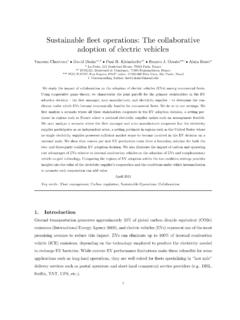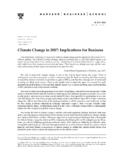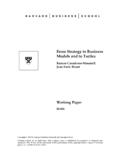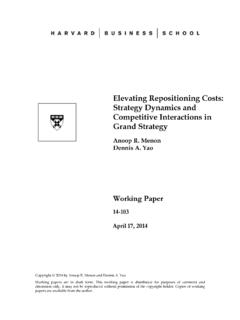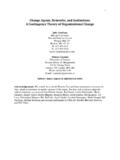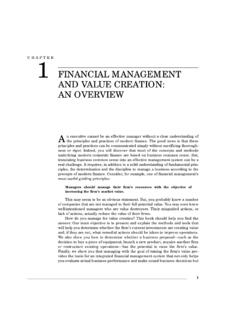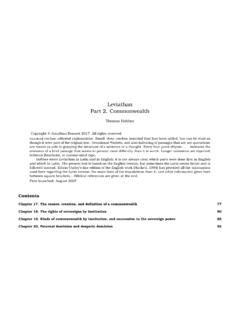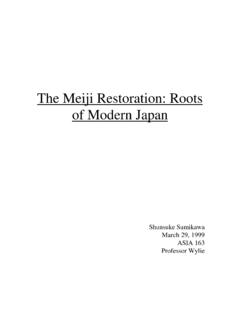Transcription of Cellophane, the New Visuality, and the Creation of Self ...
1 cellophane , the new visuality , and the Creation of Self-Service Food Retailing Ai Hisano Working Paper 17-106. cellophane , the new visuality , and the Creation of Self-Service Food Retailing Ai Hisano Harvard Business School Working Paper 17-106. Copyright 2017 by Ai Hisano Working papers are in draft form. This working paper is distributed for purposes of comment and discussion only. It may not be reproduced without permission of the copyright holder. Copies of working papers are available from the author. cellophane , the new visuality , and the Creation of Self-Service Food Retailing Ai Hisano Abstract This working paper examines how innovations in transparent packaging, specifically cellophane , in the mid-twentieth century United States helped retailers to create full self-service merchandising systems, including selling perishable food.
2 While self-service stores began appearing in the late 1910s, self-service was initially applied only to grocery and dry goods, such as canned foods and a box of breakfast cereals. It was not until after World War II that the majority of American grocers adopted self-service to meat and produce sections. Business historians have explored the development of this self-service merchandising from the perspectives of marketing strategies, store operations, and relationships between customers and store clerks. However, the significance of the development of cellophane as a new packaging material, and the role of packaging manufacturers in promoting self-service, has yet to be analyzed.
3 This working paper fills this void by showing that the expansion of self-service operation and the increasing use of transparent packaging had a significant impact not only on how consumers purchased foods but also on how they understood food quality. 1. cellophane , the new visuality , and the Creation of Self-Service Food Retailing Ai Hisano Introduction This working paper examines how innovations in transparent film became a major factor that helped expand and popularize self-service food retailing. It focuses on the American food industry roughly from the 1920s to the 1950s, a time when self-service merchandising emerged as the dominant way of selling perishable items.
4 The United States pioneered the development of a modern self-service retailing It was also the largest food market at the time. cellophane was the earliest clear packaging film. In the mid-1920s to the 1950s, it became an increasingly important packaging material in the sale of many products, including food. The film was particularly well suited to self-service retailing. It served as an effective merchandising aid for many retailers, as it helped consumers make buying decisions for themselves based on sight, while keeping food products fresh and clean.
5 By analyzing the development of cellophane and marketing rhetoric for selling transparent packaging, this working paper seeks to expand the historical understanding of self- service food retailing. Historians have explored how the emergence of new food packaging, such as cartons and cans, changed food retailing and purchasing substantially in the late nineteenth and early twentieth They have also examined extensively the transformation of food distribution and retailing systems and the rise of self-service stores by analyzing the development 1. Andrew Alexander, Gareth Shaw, and Louise Curth, Promoting Retail Innovation: Knowledge Flows During the Emergence of Self-Service and Supermarket Retiling in Britain, Environment and Planting A 37 (5) (2005): 805- 821.
6 2. Susan Strasser, Satisfaction Guaranteed: The Making of the American Mass Market (New York: Pantheon Books, 1989). 2. of marketing strategies, the transformation of architectural structures and grocery operation, the shifting relationships between customers and store clerks, and consumer reactions to the introduction of self-service This study adds to the existing historical literature on self-service retailing by showing that the transformation of food packaging was a crucial factor in establishing a self-service system. In his historical study of the meat-packing industry, Roger Horowitz identified the introduction of cellophane as a key driver in developing the self-service retailing of fresh meat.
7 By analyzing the production and marketing of the transparent film, Horowitz also discussed the role of E. I. du Pont de Nemours & Company (hereafter DuPont) the primary manufacturer of cellophane in the United States in promoting self-service While advertising the use of cellophane , DuPont stressed the advantage of self-service merchandising, including the ease of handling products, better visibility, and quicker service. This working paper builds on Horowitz's argument that cellophane and its manufacturer, DuPont, played a critical role in expanding and popularizing self-service operation in grocery businesses.
8 Yet the paper broadens his focus on meat products and provides broader consequences of the increasing use of transparent packaging and the expansion of self-service operation. By examining the importance of cellophane as a scientific and modern material in a particular historical and cultural 3. Andrew Alexander, Simon Phillips, and Gareth Shaw, Retail Innovation and Shopping Practices: Consumers'. reactions to Self-Service Retailing Environment and Planning A 40 (9) (2008): 2204-2221; Adrian R. Bailey, Gareth Shaw, Andrew Alexander, and Dawn Nell, Consumer Behaviour and the Life-Course: Shopper reactions to Self Service Grocery Shops and Supermarkets in England , Environment and Planning A 42 (6).
9 (2010): 1496-1512; Tracey Deutsch, Building a Housewife's Paradise: Gender, Politics, and American Grocery Stores in the Twentieth Century (Chapel Hill: University of North Carolina Press, 2010); Peter Lummel, Born-in- the-City: The Supermarket in Germany, in Food and the City in Europe since 1800, eds. Peter J. Atkins, Peter Lummel, and Derek J. Oddy (New York: Routledge, 2007): 165-76; James M. Mayo, The American Grocery Store: The Business Evolution of an Architectural Space (Westport, CT: Greenwood Press, 1993); and Richard S. Tedlow, New and Improved: The Story of Mass Marketing in America (Boston: Basic Books, 1996); Leigh Sparks, The Rise and Fall of Mass Marketing?
10 : Food Retailing in Great Britain since 1960, in The Rise and Fall of Mass Marketing, eds. Richard S. Tedlow and Geoffrey Jones (New York: Routledge, 1993): 58-92. 4. Roger Horowitz, Putting Meat on the American Table: Taste, Technology, Transformation (Baltimore: Johns Hopkins University, 2006). 3. context in the early- to mid-twentieth-century United States, this paper also examines how business strategies helped shape, and were shaped by, cultural narratives about cellophane . After examining the development of cellophane and of self-service operation, this paper concludes with consequences of this new merchandising system and of the increasing use of cellophane .
